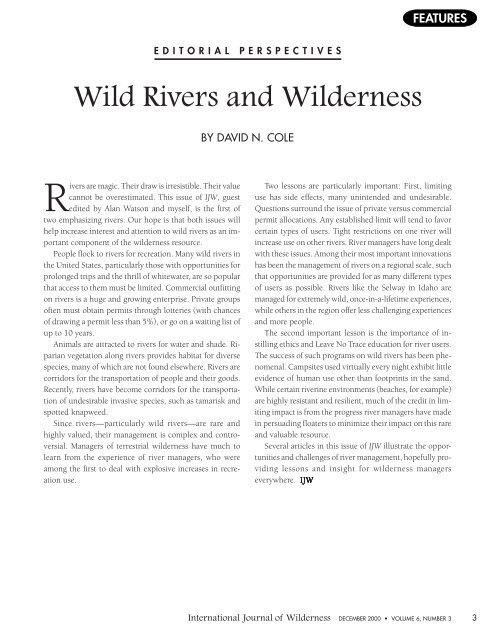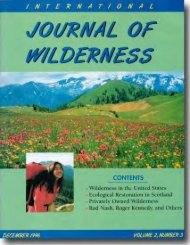Download full PDF - International Journal of Wilderness
Download full PDF - International Journal of Wilderness
Download full PDF - International Journal of Wilderness
You also want an ePaper? Increase the reach of your titles
YUMPU automatically turns print PDFs into web optimized ePapers that Google loves.
Rivers are magic. Their draw is irresistible. Their value<br />
cannot be overestimated. This issue <strong>of</strong> IJW, guest<br />
edited by Alan Watson and myself, is the first <strong>of</strong><br />
two emphasizing rivers. Our hope is that both issues will<br />
help increase interest and attention to wild rivers as an important<br />
component <strong>of</strong> the wilderness resource.<br />
People flock to rivers for recreation. Many wild rivers in<br />
the United States, particularly those with opportunities for<br />
prolonged trips and the thrill <strong>of</strong> whitewater, are so popular<br />
that access to them must be limited. Commercial outfitting<br />
on rivers is a huge and growing enterprise. Private groups<br />
<strong>of</strong>ten must obtain permits through lotteries (with chances<br />
<strong>of</strong> drawing a permit less than 5%), or go on a waiting list <strong>of</strong><br />
up to 10 years.<br />
Animals are attracted to rivers for water and shade. Riparian<br />
vegetation along rivers provides habitat for diverse<br />
species, many <strong>of</strong> which are not found elsewhere. Rivers are<br />
corridors for the transportation <strong>of</strong> people and their goods.<br />
Recently, rivers have become corridors for the transportation<br />
<strong>of</strong> undesirable invasive species, such as tamarisk and<br />
spotted knapweed.<br />
Since rivers—particularly wild rivers—are rare and<br />
highly valued, their management is complex and controversial.<br />
Managers <strong>of</strong> terrestrial wilderness have much to<br />
learn from the experience <strong>of</strong> river managers, who were<br />
among the first to deal with explosive increases in recreation<br />
use.<br />
EDITORIAL PERSPECTIVES<br />
Wild Rivers and <strong>Wilderness</strong><br />
BY DAVID N. COLE<br />
FEATURES<br />
Two lessons are particularly important: First, limiting<br />
use has side effects, many unintended and undesirable.<br />
Questions surround the issue <strong>of</strong> private versus commercial<br />
permit allocations. Any established limit will tend to favor<br />
certain types <strong>of</strong> users. Tight restrictions on one river will<br />
increase use on other rivers. River managers have long dealt<br />
with these issues. Among their most important innovations<br />
has been the management <strong>of</strong> rivers on a regional scale, such<br />
that opportunities are provided for as many different types<br />
<strong>of</strong> users as possible. Rivers like the Selway in Idaho are<br />
managed for extremely wild, once-in-a-lifetime experiences,<br />
while others in the region <strong>of</strong>fer less challenging experiences<br />
and more people.<br />
The second important lesson is the importance <strong>of</strong> instilling<br />
ethics and Leave No Trace education for river users.<br />
The success <strong>of</strong> such programs on wild rivers has been phenomenal.<br />
Campsites used virtually every night exhibit little<br />
evidence <strong>of</strong> human use other than footprints in the sand.<br />
While certain riverine environments (beaches, for example)<br />
are highly resistant and resilient, much <strong>of</strong> the credit in limiting<br />
impact is from the progress river managers have made<br />
in persuading floaters to minimize their impact on this rare<br />
and valuable resource.<br />
Several articles in this issue <strong>of</strong> IJW illustrate the opportunities<br />
and challenges <strong>of</strong> river management, hope<strong>full</strong>y providing<br />
lessons and insight for wilderness managers<br />
everywhere. IJW<br />
<strong>International</strong> <strong>Journal</strong> <strong>of</strong> <strong>Wilderness</strong> DECEMBER 2000 • VOLUME 6, NUMBER 3 3










